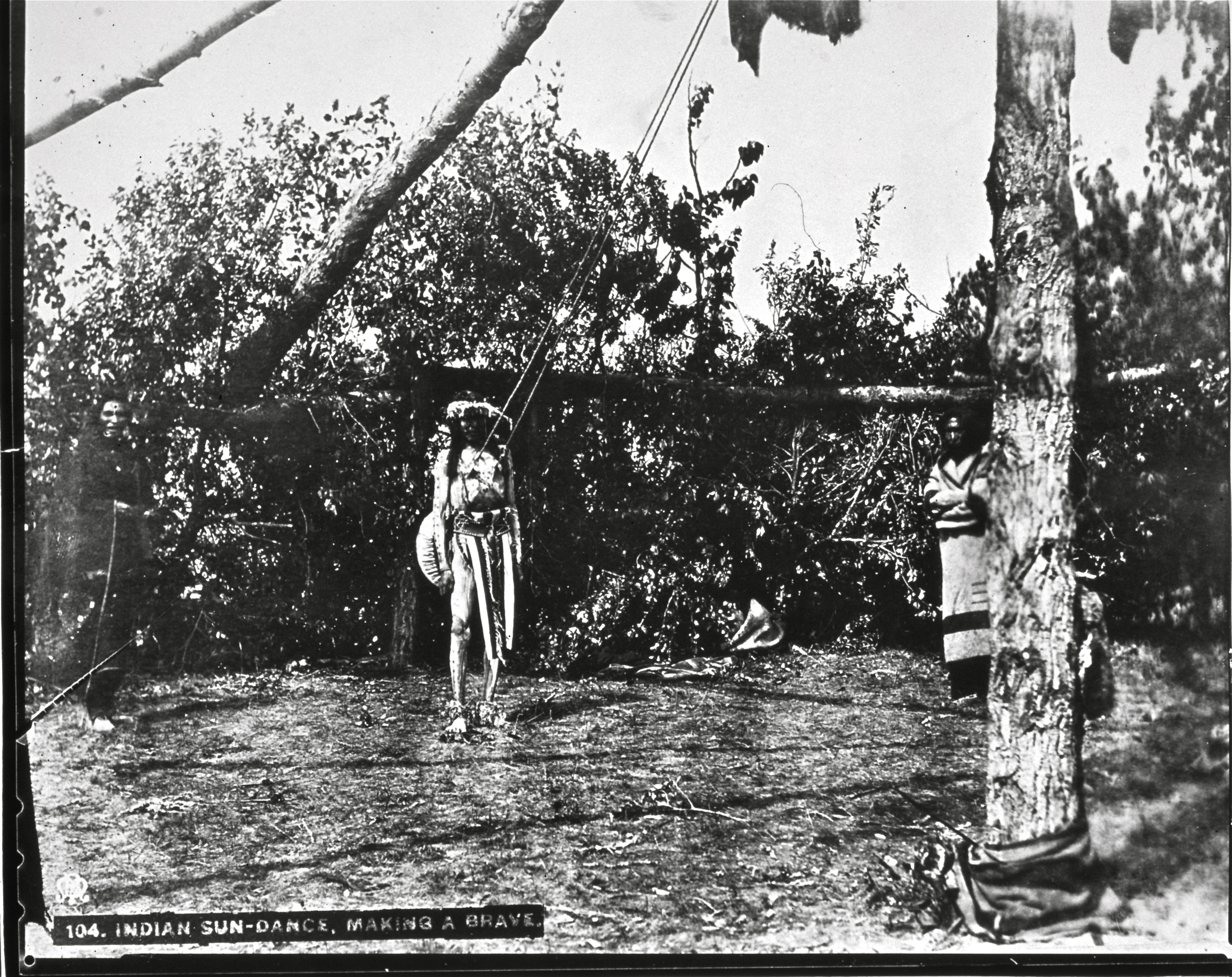By Joanna Cohan Scherer
Non-Indian Presence at the Ceremony
In trying to determine the Blackfoot attitude towards the accessibility of this event at the time, the most significant photo is Fig. 3 (right) in which a number of Anglo male spectators are visible at the right of the photo. White spectators were also present in the views showing preparations for the ceremony (Fig. 1) to the right of the blurred man in foreground and in Fig. 2 (top, blurred and faint in left background). These photos are incontrovertible evidence that non-Indians were present. Examination of the photographs themselves, in association with the historical documentation — especially newspaper accounts — attest that the self-sacrifice 13 was a public performance. It is also clear from the photographer's notes that he was granted permission by the chiefs and the dancers to photograph this event. We do not know why the chiefs gave their permission to take these photographs. It could have been that they realized that these ceremonies were under assault and they wanted them recorded.14 It also could have been a politically motivated decision to gain approval from Canadian government officials through cooperation with influential Anglo visitors, especially those connected with the media, i.e., newspapers.15 However, it was not a unanimous decision: the women and some of the younger men did not approve of the photographer's presence. This indicates that the power/authority rested with the chiefs, and also clearly shows that, like today, there was no consensus concerning the appropriateness of taking photographs of such events.
Most early cameras, especially pre-1888, were impossible to conceal; most photographs of that period were therefore taken with the full awareness and consent of the subjects. In fact, many American Indians were aware by the 1860’s-1870s of the economic profits in photography and insisted on being paid for their photographs (Blackman 1982:88, cp. Silversides 1994:7).16 Some even saw photography as an opportunity to make money. Native American celebrities such as Sarah Winnemucca, the Northern Paiute, charged 50¢ for a copy of her formal studio image (Scherer 1988:192). In a number of cases, evidence exists of individuals who did not want their photograph taken. Some turned away from the camera, put their hands up before their faces, or covered their heads (Lippard 1992:28, 31; Silversides 1994:4, 7, 9). But when a subject looked straight into the camera and at the photographer, a degree of acquiescence must be acknowledged.
Next Section: Conclusion
13 Published accounts of the piercing as a form of self-sacrifice exist as both eye-witness reports, such as those of Boorne, detailed in this paper, and as descriptions by American Indians of their personal experiences in fulfillment of their vow (for the latter, cp. Ewers 1948). Other accounts of self-sacrifice are represented in American Indian drawings. For example, Howling Wolf, Southern Cheyenne, made ledger drawings in 1876 at Fort Marion, Florida of many subjects including the piercing ritual. These originals are in the New York State Library, Special Collections, University of the State of New York, Albany. Also, Standing Bear, Minneconjou Lakota artist, depicted Sitting Bull's Sun Dance. Painted in 1889-1903 the original is now in the Foundation for the Preservation of American Indian Culture, Inc., Saint Augustine’s Indian Center, Chicago (Maurer 1992). Among twentieth-century artists, William Standing painted the self-sacrifice of the Assiniboine in 1929, and the Cheyenne artist Richard W. West painted the same in 1970.
14 Walter McClintock gives this as the reason why the Blackfeet of Montana wanted him to take photographs of many ceremonies, including the Medicine Lodge ceremony. He says that Mad Wolf "even stopped the ceremonies that I might photograph the dances, write down the words of the chants and prayers and secure graphophone records of their sacred songs. He also made a speech into the graphophone, asking that it be sent as a message to the Great Father at Washington" (McClintock 1910: 175-176; cp. 153).
15 Many Native American groups were governed by both religious and secular leaders. An interesting comparison is the nineteenth-century Zuni response to photographers in which it is clear that the religious leaders did not favor photography, but the secular leaders did (Holman 1996a; 1996b: 112).
16 The idea of photography as a means of economic exchange, especially among the Zuni is discussed in Holman (1996a).
